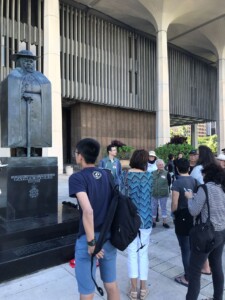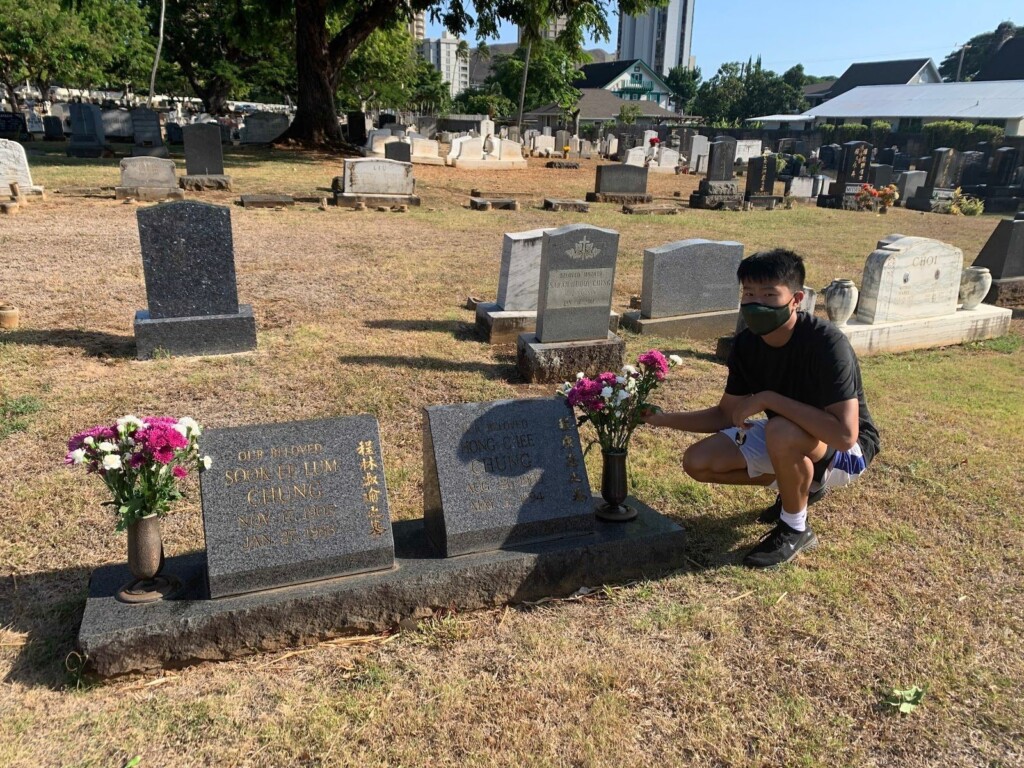
Billie Napoleon teaches an Historian Preservation & 3-D class at Mid-Pacific Institute.
Historic Hawai‘i Foundation is pleased to share an interview with Educator Billie Napoleon who taught a course on Historic Preservation and 3-D scanning at Mid-Pacific Institute in Honolulu from 2018 through the spring of 2021. Starting this fall, Napoleon began a new teaching position at Mālama Honua Charter School in Waimānalo. This article was written prior to her job change and was first published in the March 2021 issue of Historic Hawai‘i News, HHF’s printed newsletter.
In 2018, Napoleon and her Historic Preservation students collaborated with HHF and archaeology firm Cultural Surveys Hawai‘i in the development of the Capital Historic District Story Map. The students completed 3-D scans of public art in the District, helping to enhance the visual impact of the digital map.
HISTORIC HAWAI‘I FOUNDATION: Tell us a little about yourself–where are you from, what is your current profession, what are your interests and hobbies?
BILLIE NAPOLEON: I’m from Waimanalo and have been teaching for 25 years; first five at King Intermediate, and the last 20 at Mid Pacific Institute. My husband and I have three children ages 18, 22, and 24. I enjoy taking care of my vegetable garden, which began as my quarantine hobby, knitting, and cooking.
HHF: What led to your involvement with Historic Hawai‘i Foundation?
BN: When I was first given the Historic Preservation course, I had little knowledge of preservation in Hawai‘i. I knew that it would benefit my students if I partnered with experts in the field, which led me to seek out and build a relationship with Historic Hawai‘i Foundation. From the very beginning, Kiersten and Andrea have been so supportive of the class and excited that Mid Pacific students have the privilege and opportunity to explore preservation issues in their own communities. Their excitement sparked my own and over the years I have developed my own passion for both preservation and conservation in Hawai‘i. It’s through our many meetings and conversations that this interest has been nurtured.

In 2019, MPI students participated as docents in HHF’s Capital Historic District Story Map Tour, discussing the 3-D scanning project they worked on of outdoor public art in the district.
HHF: How does the 3-D scanning technology allow students to communicate the stories of their community?
BN: The 3-D scanning offers students the opportunity not only to explore historical sites and sites of interest, but also to reveal those special features that make them preservation-worthy. When we select a site, we do so with the understanding that these places, these wahi pana, serve a meaningful purpose that goes beyond the utilitarian. They offer cultural and historical significance that many students initially are unaware of. Through the use of the scanner, students are able to appreciate the fine details that make these spaces and places special. By sharing the scans, they stitch together and the fly- through videos they create, students shine a spotlight on these special sites. In this way, community members can experience them virtually and recognize the value of preservation.
HHF: Please share a little about the evolution of your Historic Preservation class during the pandemic, including innovative assignments you developed and any plans for weaving these into future curriculum.
BN: In the past, we were very focused on identifying a site of interest, researching its significance and value to the community, then taking the steps to scan it and process those scans. During the pandemic, we were unable to go on any field trips, which up until then, had been the heart and soul of this course. Since August 2020, we had to approach the class differently and it has been a wonderful evolution. Remaining in the classroom opened up another aspect of preservation: culture and heritage. We began 2021 by taking a virtual field trip to Mānoa Heritage Center. Students used that tour as a catalyst for our “Manoa Matters” podcast project, researching those aspects of Mānoa that make it special, recording a podcast, and posting it on the Mānoa Heritage site. This highlighted for all of us that preservation isn’t just about using sophisticated technology; it’s about recognizing the people and places that make a community remarkable and sharing it with others. This led us to our second project where we looked specifically at the value of cemeteries and how they add to communities both culturally and aesthetically. We all gained insight on what preservation means — beyond laws and acts — through these two experiences.
HHF: As an educator, what would you want your students to understand about their own heritage?
BN: I want my students to recognize how their heritage shapes them in ways they may not have known. I want them to know the power they have as individuals to take steps to preserve those things that contribute to their identity as well as those of their community.

Student Kyle Chun at O‘ahu Cemetery in Nu‘uanu placing flowers on his relatives’ graves.
HHF: What have you found to be most effective in inspiring young people to learn and care about historic places?
BN: It can be a slow process. People, myself included, don’t always recognize how deeply-rooted their appreciation is of certain places. This course, I hope, helps students to stop and take a look around; to pause and kilo (observe) their environment. What I’ve found to be effective is giving students a choice in the places we explore and encouraging them to connect personally with sites of interest. For example, we will end the year with students creating a Heritage Tour of their own neighborhood, highlighting those places that outsiders may not know about or appreciate. This project really gives them a sense of place and often nurtures pride in their community.
HHF: Please name a favorite historic or cultural site in Hawai‘i and tell us why this place matters to you.
BN: Two of my favorite historic and cultural sites are Kūkaniloko Birth Stones in Wahiawa and Iolani Palace. They are both so different and seem to be at opposite ends of a cultural spectrum but both contribute to the story of Hawaiian values and innovation, which, as a Hawaiian, I am in awe of.
Learn more
- Listen to the student podcast project, “Why Mānoa Matters” here: https://www.manoaheritagecenter.org/2021/01/kaaipu-kakou-20.
- Learn more about the use of 3-D scanning at Mid-Pacific Institute: Immersive Technology-Historic Preservation
- Visit the Capital Historic District Story Map here: Heritage Tourism – Oahu – Historic Hawaii Foundation

